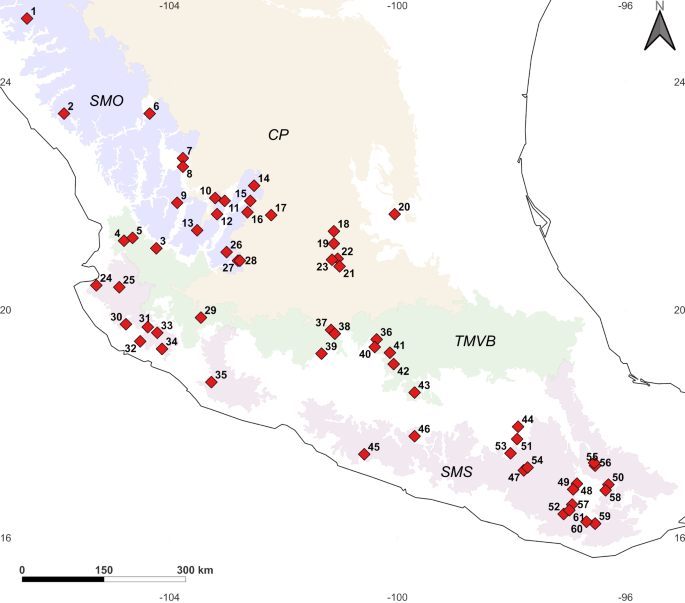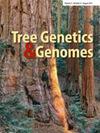墨西哥高原木兰栎(Quercus magnoliifolia)和松皮栎(Quercus resinosa)(壳斗科)的远距离传播驱动遗传变异和历史人口统计学
IF 1.6
3区 生物学
Q2 FORESTRY
引用次数: 0
摘要
杂交和渐渗虽然具有很强的适应性,但也会阻碍物种的分化。厚朴栎(Quercus magnoliifolia)和松脂栎(querus resinosa)是分布在墨西哥高地的两种特有橡树。这些物种在生态和形态上分化;然而,没有明显的核遗传分化。在这项研究中,我们确定了遗传变异模式的形成机制,并确定了迁移和杂交在这两种橡树的进化史中的作用。为了做到这一点,贝叶斯方法被用于利用叶绿体微卫星推断物种之间的迁移率、方向性和分化时间。综合物种分布模型,推测了末次间冰期、末次盛冰期和全新世中期木兰和松柏的地理分布。我们没能区分出每个物种独特的基因组成。叶绿体分化更符合地理特征,而不是各物种的分类地位。我们的研究表明,在散度(c。这两种橡树的高渗率发生在更新世末期。此外,过去的分布模式预测厚朴与松脂可能在末次盛冰期以来处于同生状态,松脂可能在中全新世前后在地理上向现在的分布方向扩展。这种扩张得到了迁移模型测试的支持,表明最近在跨墨西哥火山带北部建立了Q. resinosa。我们假设厚朴和松柏分化后,发生了定植事件,随后发生了栎树之间的杂交和长距离种子传播,从而解释了现在的叶绿体多样性分布模式。我们认为,在自然选择的作用下,物种的分化主要集中在位点上,这为橡树物种边界的“多孔性”提供了证据。本文章由计算机程序翻译,如有差异,请以英文原文为准。

Long-distance dispersal drives the genetic variation and historical demography of Quercus magnoliifolia and Quercus resinosa (Fagaceae) in the Mexican highlands
Abstract While hybridization and introgression can have a strong adaptive importance, it can impede divergence of species. Quercus magnoliifolia and Q. resinosa are two endemic oak species distributed across the Mexican highlands. These species diverged ecological and morphologically; however, no nuclear genetic differentiation is evident. In this study, we determined the mechanisms that shape patterns of genetic variation and establish the role of migration and hybridization in the evolutionary history of these two oak species. To do this, Bayesian approaches were used for inference on migration rates and directionality and timing of divergence between species using chloroplast microsatellites. We then integrated species distribution models to infer the geographic distribution of Q. magnoliifolia and Q. resinosa during Last Interglacial, Last Glacial Maximum, and Mid-Holocene time frames. We failed in distinguishing a unique genetic composition for each species. Chloroplast differentiation was more congruent with geography than the taxonomic status of each species. Our study revealed that after the divergence ( c . 10 Mya) of these two oak species, high rates of introgression took place at the end of the Pleistocene. Furthermore, past distribution models predicted that Q. magnoliifolia and Q. resinosa have likely been in sympatry presumable since Last Glacial Maximum and Q. resinosa probably expanded geographically towards its current distribution around Mid-Holocene. This expansion was supported by testing migration models, suggesting recent establishment of Q. resinosa to the north of Trans-Mexican Volcanic Belt. We hypothesized that after Q. magnoliifolia and Q. resinosa diverged, colonization events followed by hybridization between oaks and long-distance seed dispersal occurred, explaining the present-day patterns of distribution of chloroplast diversity. We propose that divergence of species remains mainly on loci under natural selection, providing evidence on the “porous” nature of species boundaries among oaks.
求助全文
通过发布文献求助,成功后即可免费获取论文全文。
去求助
来源期刊

Tree Genetics & Genomes
生物-林学
CiteScore
4.40
自引率
4.20%
发文量
38
审稿时长
2 months
期刊介绍:
Tree Genetics and Genomes is an international, peer-reviewed journal, which provides for the rapid publication of high quality papers covering the areas of forest and horticultural tree genetics and genomics.
Topics covered in this journal include:
Structural, functional and comparative genomics
Evolutionary, population and quantitative genetics
Ecological and physiological genetics
Molecular, cellular and developmental genetics
Conservation and restoration genetics
Breeding and germplasm development
Bioinformatics and databases
Tree Genetics and Genomes publishes four types of papers:
(1) Original Paper
(2) Review
(3) Opinion Paper
(4) Short Communication.
 求助内容:
求助内容: 应助结果提醒方式:
应助结果提醒方式:


